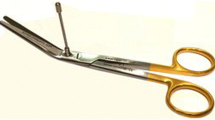Abstract
Introduction and hypothesis
Episiotomy is regarded as the most common maternal obstetric surgical procedure. It is associated with a significant increase in blood loss, lower pelvic floor muscle strength, dyspareunia, and perineal pain compared with a perineal tear. We tested the hypothesis that all doctors and midwives can perform an episiotomy when prompted to, specifically cut at 60° from the midline (in a simulation model).
Methods
Doctors and midwives attending the BMFMS Annual Meeting (2014), Croydon Perineal Trauma Course and staff at Poole General Hospital were invited to cut a paper replica of the perineum with a commonly used episiotomy incision pad. Participants were prompted to cut an episiotomy at 60° to the perineal midline with the anus as a reference point. The angles and distances were measured using protractors and rulers. A 58–62° band was deemed acceptable to account for measurement errors.
Results
A total of 106 delegates participated. Only 15 % of doctors and midwives cut an episiotomy between 58 and 62°. Over one third (36 %) cut the episiotomy between 55 and 65° (inclusive). Nearly two thirds either underestimated the angle (<55°; 44 %), or overestimated the angle (>66°; 18 %). Thirty-six and 7.5 % of episiotomies were cut at <50 and >70° respectively. The origination point of the episiotomy was 5 mm away from the midline (IQR 1–8 mm).
Conclusions
This original observational study shows that doctors and midwives were poor at cutting at the prompted episiotomy angle of 60°. This highlights the need to develop structured training programmes to improve the visual accuracy of estimating angles or the use of fixed angle devices to help improve the ability to estimate the desired angle.


Similar content being viewed by others
Abbreviations
- OASIs:
-
Obstetric anal sphincter injuries
- NICE:
-
National Institute for Health and Care Excellence
References
De Leeuw JW, de Wit C, Kuijken JP, Bruinse HW (2008) Mediolateral episiotomy reduces the risk for anal sphincter injury during operative vaginal delivery. BJOG 115(1):104–108. doi:10.1111/j.1471-0528.2007.01554.x
Seijmonsbergen-Schermers AE, Geerts CC, Prins M, van Diem MT, Klomp T, Lagro-Janssen AL, de Jonge A (2013) The use of episiotomy in a low-risk population in the Netherlands: a secondary analysis. Birth 40(4):247–255. doi:10.1111/birt.12060
Carroli G, Mignini L (2009) Episiotomy for vaginal birth. Cochrane Database Syst Rev 1, CD000081. doi:10.1002/14651858.CD000081.pub2
Fodstad K, Staff AC, Laine K (2014) Effect of different episiotomy techniques on perineal pain and sexual activity 3 months after delivery. Int Urogynecol J. doi:10.1007/s00192-014-2401-2
Coats PM, Chan KK, Wilkins M, Beard RJ (1980) A comparison between midline and mediolateral episiotomies. Br J Obstet Gynaecol 87(5):408–412
Bliss DZMA, Whitehead WE, Chiarioni G, Emmanuel A, Santoro GA, Zbar A, Peden-McAlpine C, Northwood M, Slieker-Ten Hove M, Berghmans B, Mimura T (2013) Assessment and conservative management of faecal incontinence and quality of life in adults. In: Abrams P, Cardozo L, Khoury S, Wein A (eds) Incontinence, 5th edn. International Consultation on Urological Diseases and European Association of Urology, Paris, pp 1444–1485
Madoff RD, Laurberg S, Lehur P, Matzel KE, Mellgren AF, Mimura T, O’Connell PR, Varma MG (2013) Surgery for faecal incontinence. In: Abrams P, Cardozo L, Khoury S, Wein A (eds) Incontinence. 5th edn. International Consultation on Urological Diseases and European Association of Urology, Paris, pp 1487–1526
Andrews V, Thakar R, Sultan AH, Jones PW (2005) Are mediolateral episiotomies actually mediolateral? BJOG 112(8):1156–1158. doi:10.1111/j.1471-0528.2005.00645.x
Eogan M, Daly L, O’Connell PR, O’Herlihy C (2006) Does the angle of episiotomy affect the incidence of anal sphincter injury? BJOG 113(2):190–194. doi:10.1111/j.1471-0528.2005.00835.x
Stedenfeldt M, Pirhonen J, Blix E, Wilsgaard T, Vonen B, Oian P (2012) Episiotomy characteristics and risks for obstetric anal sphincter injuries: a case–control study. BJOG 119(6):724–730. doi:10.1111/j.1471-0528.2012.03293.x
Kalis V, Karbanova J, Horak M, Lobovsky L, Kralickova M, Rokyta Z (2008) The incision angle of mediolateral episiotomy before delivery and after repair. Intl J Gynaecol Obstet 103(1):5–8. doi:10.1016/j.ijgo.2008.05.026
Kalis V, Landsmanova J, Bednarova B, Karbanova J, Laine K, Rokyta Z (2011) Evaluation of the incision angle of mediolateral episiotomy at 60 degrees. Intl J Gynaecol Obstet 112(3):220–224. doi:10.1016/j.ijgo.2010.09.015
Freeman RM, Hollands HJ, Barron LF, Kapoor DS (2014) Cutting a mediolateral episiotomy at the correct angle: evaluation of a new device, the Episcissors-60. Med Devices (Auckl) 7:23–28. doi:10.2147/MDER.S60056
Patel RP, Ubale SM (2014) Evaluation of the angled Episcissors-60((R)) episiotomy scissors in spontaneous vaginal deliveries. Med Devices (Auckl) 7:253–256. doi:10.2147/MDER.S66901
Wong KW, Ravindran K, Thomas JM, Andrews V (2014) Mediolateral episiotomy: are trained midwives and doctors approaching it from a different angle? Eur J Obstet Gynecol Reprod Biol 174:46–50. doi:10.1016/j.ejogrb.2013.12.002
Tincello DG, Williams A, Fowler GE, Adams EJ, Richmond DH, Alfirevic Z (2003) Differences in episiotomy technique between midwives and doctors. BJOG 110(12):1041–1044
Fodstad K, Laine K, Staff AC (2013) Different episiotomy techniques, postpartum perineal pain, and blood loss: an observational study. Int Urogynecol J 24(5):865–872. doi:10.1007/s00192-012-1960-3
NICE (2007) Intrapartum care—care of healthy women and their babies during childbirth, vol CG55. NICE, Manchester
Silf K, Woodhead N, Kelly J, Fryer A, Kettle C, Ismail KM (2015) Evaluation of accuracy of mediolateral episiotomy incisions using a training model. Midwifery. 31(1):197–200. doi:10.1016/j.midw.2014.08.009
Eliashiv OGS, Weiner E, Sadan O, Golan A, Condrea A (2013) Mediolateral episiotomy—is the angle of incision performed at crowning the correct and desired one? Int Urogynecol J 24(1):S68
Conflicts of interest
M. Naidu, S. Evans, L. Vinayakrao, A.H. Sultan, R. Thakar: none. D.S. Kapoor: co-inventor of the EPISCISSORS-60 episiotomy scissors. He is a shareholder of Medinvent Ltd, the company that owns the commercial rights to the scissors.
Author information
Authors and Affiliations
Corresponding author
Rights and permissions
About this article
Cite this article
Naidu, M., Kapoor, D.S., Evans, S. et al. Cutting an episiotomy at 60 degrees: how good are we?. Int Urogynecol J 26, 813–816 (2015). https://doi.org/10.1007/s00192-015-2625-9
Received:
Accepted:
Published:
Issue Date:
DOI: https://doi.org/10.1007/s00192-015-2625-9




